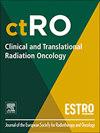低分割立体定向放疗治疗的非小细胞肺癌脑转移瘤的预后因素、失败模式和再照射
IF 2.7
3区 医学
Q3 ONCOLOGY
引用次数: 0
摘要
背景:低分割立体定向放疗(fSRT)越来越多地用于非小细胞肺癌(NSCLC)脑转移(BMs)。然而,关于fSRT的治疗结果和fSRT再照射的临床应用(re-fSRT)的相关数据仍然很少。方法纳入2018年5月至2022年5月连续接受fsrt治疗的非小细胞肺癌脑转移患者。从fSRT开始计算颅内局部复发(iLR)、颅内进展性疾病(iPD)和症状性放射性坏死(sRN)的累积发生率,选择死亡作为竞争事件。有限iPD(数量≤5,大小≤3cm)且12个月内未发生iLR的患者被归类为re-fSRT候选者。研究了re-fSRT的临床价值和sRN的剂量学预测指标。结果218例患者中位随访时间为22.3个月,1年、2年和3年累计iLR发生率分别为8.1%、12.3%、17.8%。生物有效剂量、肿瘤总体积和同时的全身治疗与iLR的发生风险相关。值得注意的是,59例iPD患者中有45例(76.3%)可进行再fsrt。45名候选人中有19名(42.2%)进行了Re-fSRT,并与生存率提高相关(p = 0.010)。全人群1年、2年和3年sRN累计发病率分别为4.5%、10.3%、17.7%。此外,接受再fsrt的患者中有3例(15.8%)发生sRN,并且发现脑V20Gy与sRN的风险相关。结论fsrt治疗局限性非小细胞肺癌脑转移是一种很有前景的治疗方法,一些患者可能从fsrt治疗中获益。本文章由计算机程序翻译,如有差异,请以英文原文为准。
Prognostic factors, patterns of failure and re-irradiation in hypofractionated stereotactic radiotherapy-treated brain metastases from non-small cell lung cancer
Background
Hypofractionated stereotactic radiotherapy (fSRT) is increasingly used for brain metastases (BMs) from non-small cell lung cancer (NSCLC). However, relevant data concerning treatment outcomes of fSRT and clinical utility of re-irradiation using fSRT (re-fSRT) remain scarce.
Methods
Consecutive NSCLC patients with fSRT-treated BMs from May 2018 to May 2022 were included. The cumulative incidence of intracranial local recurrence (iLR), intracranial progressive disease (iPD) and symptomatic radiation necrosis (sRN) were calculated from the initiation of fSRT, choosing death as the competing event. Patients with limited iPD (number ≤5 and size ≤3 cm) and without iLR developed within 12 months, were classified as re-fSRT candidates. The clinical value of re-fSRT and dosimetric predictors of sRN were investigated.
Results
With a median follow-up of 22.3 months, the 1-year, 2-year and 3-year cumulative incidence of iLR among the 218 identified patients were 8.1 %, 12.3 %, 17.8 %, respectively. Biological effective dose, total tumor volume and concurrent systemic therapy were associated with the risk of iLR. Notably, 45 (76.3 %) of the 59 patients with iPD were feasible for re-fSRT. Re-fSRT was performed in 19 (42.2 %) of the 45 candidates and associated with improved survival (p = 0.010). The 1-year, 2-year and 3-year cumulative incidence of sRN in the whole population were 4.5 %, 10.3 %, 17.7 %, respectively. Moreover, sRN occurred in 3 (15.8 %) patients receiving re-fSRT and Brain V20Gy was found to be associated with the risk of sRN.
Conclusion
fSRT is a promising treatment for limited BMs from NSCLC and some patients may benefit from re-fSRT.
求助全文
通过发布文献求助,成功后即可免费获取论文全文。
去求助
来源期刊

Clinical and Translational Radiation Oncology
Medicine-Radiology, Nuclear Medicine and Imaging
CiteScore
5.30
自引率
3.20%
发文量
114
审稿时长
40 days
 求助内容:
求助内容: 应助结果提醒方式:
应助结果提醒方式:


